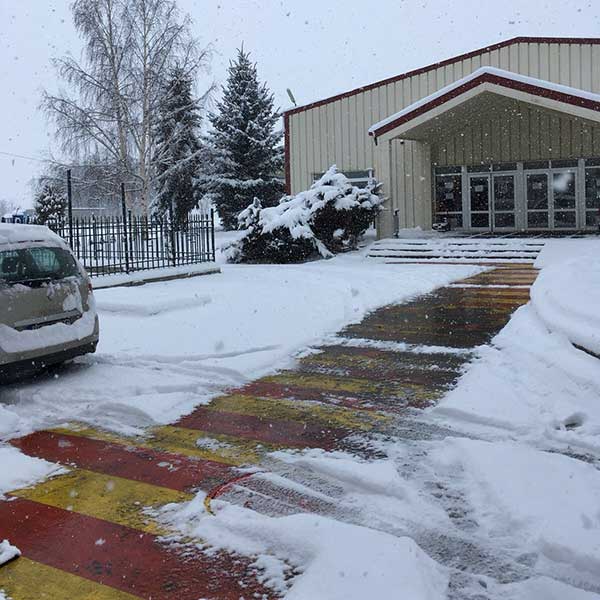Calendar Icon
May 07, 2018
Person Bust Icon
By Karl Vogel
![]() RSS
Submit a Story
RSS
Submit a Story

RELATED LINKS
- Chris Tuan's video about conductive concrete
- Video about conductive concrete on CBS's "The Henry Ford's Innovation Nation"
Many factors came together – viral videos and an East Coast blizzard, in particular – to help create a buzz about conductive concrete, invented by Nebraska Engineering faculty Chris Tuan and Lim Nguyen.
In the past few years, network television shows and major news outlets have told the story of the electrified concrete that melts snow and ice and can shield buildings from electromagnetic attacks and have sparked global interest.
There have been inquiries from Canada, China, Japan and Turkey.
Among those paying attention was Aurubis, a leading worldwide provider of non-ferrous metals that was looking for ways to monetize a manufacturing byproduct.
“When they make copper, Aurubis also makes this fine, iron-rich sand, and they wanted to find an outlet to sell it,” said Tuan, professor of civil engineering, who developed the concrete with Nguyen, professor of electrical and computer engineering. “Their commercial director (Vladislav Petrov) contacted me to see if he could use this sand in the de-icing concrete. He sent me some samples, and I thought it was something worth looking into.”
Tuan contacted NUtech Ventures, the intellectual property and commercialization affiliate of the University of Nebraska-Lincoln. Maurico Suarez, NUtech’s licensing director, and Zane Gernhart, technology manager, negotiated a licensing agreement that allowed both the university and the European company to test the new concrete mixture.
The collaboration, Tuan said, has worked very smoothly and resulted in a 700-square foot walkway between two Aurubis buildings in Pirdop, Bulgaria.
“We both did some tests and it turns out the iron-rich sand works very well. We (Tuan and Nguyen) told them the specs for the conductive concrete materials and the electrical power system and the construction sequence, and all the communication was all by phone and computer,” Tuan said.
“Aurubis did a very good job. The system is operational. And this proves you don’t have to be a well-trained person in electrical applications to use it or install it.”
Suarez said this agreement with Aurubis is an example of a good deal that came together for the right reasons – in this case, providing another opportunity to apply the technology and provide further proof about its safety and the ease of its implementation.
Importantly for conductive concrete, Suarez said, is getting it exposure that will improve its reputation.
“Because this technology – electricity running through concrete – is very new, people often ask about its safety,” Suarez said. “Even though you can touch the concrete without experiencing a shock and experts can provide a scientific explanation of why you should not be concerned, people still hesitate. Just like microwave energy took many, many years for people to have it in their homes and feel comfortable, this technology requires people to get familiarized with it.
“Aurubis demonstrated its safety again and showed how easy it is to implement. Maybe this mix will make the installation process more affordable, which is important for us to make it more universal.”
Tuan knows the possibility exists for someone to turn conductive concrete into a big, money-making venture but said he would rather have the technology be available to help people all over the world. Partnering with NUtech, he said, has moved things one step closer to that goal.
“The pie is so big, there’s enough for everybody,” Tuan said. “NUtech is really the hero behind the scene. They work hard and they’re great cheerleaders for our faculty and our inventions. We can just give it to them and let them run.”
Submit a Story

